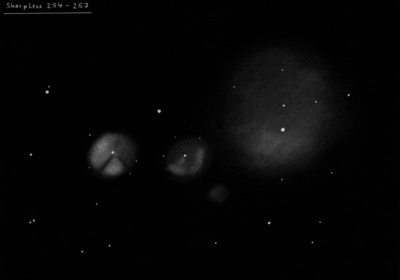
E.E. Barnard discovered IC 2162 visually on 30 Nov 1888 with the 12-inch refractor at Lick Observatory. He first logged in his notebook "Found a v. difficult neb close f and involving a 10m star." He added the comments "vF neb, pL, roundish, densest part following the 10m star." His field sketch and approximate offset from mag 5.9 HD 42954 pins down the identification with Sh 2-255 (eastern of a pair of faint HII glows). Barnard notified Dreyer directly of the discovery.
400/500mm - 17.5" (3/2/02): at 100x unfiltered, IC 2162 was visible as the following of two faint, round glows surrounding mag 10.5-11 stars. IC 2162 = Sh 2-255 is the brighter and larger of the pair, nearly 4' in diameter and quite symmetric. Just under 5' due west is a separate 3' fainter glow (Sh 2-257). This pair of low excitation emission knots is situated midway between two mag 6 stars with a 50' separation near the edge of the 20mm Nagler field. Close southwest of Sh 2-257 is a very faint patch of nebulosity, Sh 2-256, but this was not seen visually, nor was the larger HII region Sh 2-254, a low surface brightness glow to the west (11' diameter).
600/800mm - 24" (2/5/13): IC 2162 = Sh 2-255 is the brightest and easternmost of four round low-excitation emission glows with Sh 2-257 and Sh 2-254 lined up roughly to the west. Using 125x (21mm Ethos) and H-beta filter, it appeared as a moderately bright, round glow, ~3.5' diameter, surrounding the mag 11.6 exciting star. Sh 2-257 lies 5' W, and is a similar size, but surrounds several stars and has a lower surface brightness. Sh 2-256 is a very faint detached glow off the SW side.
Notes by Steve Gottlieb